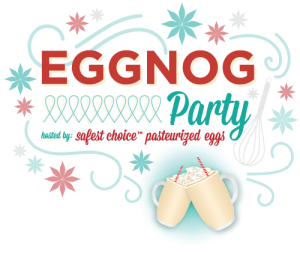Katrina Levine, extension associate at NC State University writes:
The holidays are a time when we come together to celebrate and mingle over food and drinks, especially eggnog and other egg-containing drinks. Restaurants, bars, and your bartending neighbor often feature foamy, frothy egg cocktails this time of year, but are they all that they’re cracked up to be?
Back in the summer, it was a dark and stormy night when I entered the dimly-lit Raleigh speakeasy. A jazz band was playing a chaotic Charlie Parker-inspired song and the bar was packed with people sipping some exotic-looking cocktails.  I approached the bar to order and out of the corner of my eye I saw the bartender whip out an egg and crack it directly into someone’s drink (me, right, not quite exactly as shown).
I approached the bar to order and out of the corner of my eye I saw the bartender whip out an egg and crack it directly into someone’s drink (me, right, not quite exactly as shown).
Raw egg-containing cocktails are an emerging trend in the local bar scene. Fizzes, flips, sours, and even eggnog often contain raw whole eggs, whites, or yolks. While they may be tasty, the risk of acquiring Salmonella from one of them is uncertain.
 Consuming raw or undercooked eggs has been linked to many foodborne illness outbreaks of salmonellosis. A recent Michigan outbreak sickening 32 and one in North Carolina in 2012 making 29 people ill were both likely caused by eating raw egg-based sauces. A major outbreak of salmonellosis in 2010 infected almost 2,000 people in 11 states (CDC, 2010). A table of raw egg-related outbreaks in can be found here. Hens that are infected with Salmonella Enteritidis, the most common strain in eggs, can pass on the bacteria directly to the eggs forming in their ovaries (Gantois et al., 2009). This is the mostly likely route of contamination (Gantois et al., 2009). There is not enough research to show which part of the egg has the greatest amount of contamination from this route, although the shell, membranes, white (albumen), and yolk can all become contaminated (Gantois et al., 2009).
Consuming raw or undercooked eggs has been linked to many foodborne illness outbreaks of salmonellosis. A recent Michigan outbreak sickening 32 and one in North Carolina in 2012 making 29 people ill were both likely caused by eating raw egg-based sauces. A major outbreak of salmonellosis in 2010 infected almost 2,000 people in 11 states (CDC, 2010). A table of raw egg-related outbreaks in can be found here. Hens that are infected with Salmonella Enteritidis, the most common strain in eggs, can pass on the bacteria directly to the eggs forming in their ovaries (Gantois et al., 2009). This is the mostly likely route of contamination (Gantois et al., 2009). There is not enough research to show which part of the egg has the greatest amount of contamination from this route, although the shell, membranes, white (albumen), and yolk can all become contaminated (Gantois et al., 2009).
Eggs can also become contaminated by penetration through the shell when exposed to things like feces contaminated with Salmonella (Gantois et al., 2009). Because a shell is porous, the bacteria can still find ways to get through the shell and into the egg. The shell of the egg is more likely to become contaminated than the inside of the egg, and egg yolks are less likely than whites to contain Salmonella because the antimicrobial properties of the white can reduce or eliminate the bacteria (Gantois et al., 2009). But if the shell has Salmonella and it comes in contact with the egg, such as when you crack it, you could contaminate the egg inside (i.e., cross-contamination). Washing eggs won’t help you – it actually makes contamination more likely (USDA FSIS, 2011).
Salmonella Enteritidis is found in an average of 1 in every 20,000 eggs (Ebel & Schlosser, 2000). Contamination rates are also influenced by percentage of infected hens in a flock and time between infection and producing eggs (Braden 2006).
The U.S. produces about 80 billion eggs for consumers annually, roughly 30% of which are pasteurized (USDA NASS, 2014; USDA FSIS 2013). If 1 in 20,000 have Salmonella Entertidis, that equals about 2.8 million contaminated eggs, some of which may end up at bars, restaurants, or home kitchens.
Ok, so say you’re lucky #20,000. What are the chances you’ll get sick? It’s unclear whether the risk of illness is impacted by adding Salmonella-containing egg into an alcoholic drink. The literature suggests that there are at least a couple of factors that may affect survival and destruction of the pathogen: pH and alcohol content.
Consuming alcohol along with a pathogen may have a protective effect. Epidemiologists showed in a 2002 outbreak investigation report that there was a protective effect among people who drank more than 40 grams of alcohol (that’s about 2 pints of beer or 2-3 glasses of wine) (Bellido-Blasco et al., 2002). The infection rate of those who had more than 40 grams was 54%, compared with 78% and 95% for those who had less than 40 grams and no alcohol, respectively (Bellido-Blasco et al., 2002).
In 2008, researchers at Rockefeller University investigated whether spiking eggnog would kill Salmonella, but their results were inconclusive (and weren’t published in a peer-reviewed journal). Even though the drink was made with 14% alcohol, it was initially packed with bacteria, no Salmonella was recovered after sitting in the fridge about 3 weeks (Rockefeller University, 2008).
Yet another study on wine examined the antimicrobial effects of unadulterated wine and the role of some of its constituents – total phenols, ethanol, and pH – on antimicrobial activity (Boban et al, 2010). They tested intact wine, wine with the phenols removed, wine with the alcohol removed, ethanol, a low pH, and ethanol and a low pH combined, against Salmonella Enteritis and E. coli (Boban et al., 2010). Even though the pH and alcohol content were similar among all samples, intact wine had the highest amount of antimicrobial activity, while non-intact versions had lower antimicrobial activity (Boban et al., 2010). Ethanol alone and low pH alone had negligible antibacterial activity, but when combined had a greater activity (Boban et al., 2010). While the alcohol content and pH seem to have some sort of effect on the antimicrobial effects of wine, the effect can’t be attributed to the alcohol, pH, or any of the other components specifically (Boban et al., 2010).
Acidity is also a factor. Salmonella won’t grow below a pH of about 3.6-4.0 (Lanciotti et al., 2001; Perales & Garcia, 1990), so the overall concentration and combination of ingredients in the drink would have to be at 4.0 or below to kill the bacteria.
Different forms of alcohol may be more or less acidic (Lazar, 2011). Grape-based forms, like sherries and vermouths, are more acidic, while distilled spirits, like gin and vodka, generally have a neutral pH, because the distillation process removes the acidity. Other additions to the alcohol can impact pH as well. Citrus ingredients like lemon and lime juices are by far the most acidic with a pH of about 2-3 (Lazar, 2011). Several experiments have mixed an acid, like lemon juice, vinegar, or citric acid, with mayonnaise made with raw eggs to see if it reduces Salmonella. Results show, though, that adding acid alone does not seem to reduce the bacteria to undetectable levels unless left to sit for at least an hour at 25°C (about 77°F) (Zhu, Li, and Chen, 2012). Warmer temperatures actually seemed to help kill more bacteria because cell membranes are more permeable, allowing more acid to enter bacterial cells (Zhu, Li, and Chen, 2012). Since most raw egg cocktails are kept cold and consumed quickly, a splash of lime juice probably wouldn’t be enough to lower the pH of the whole drink.
The bottom line is that the risk of getting a raw egg cocktail contaminated with Salmonella is low based on the egg contamination rates, but if you win the contaminated egg lottery, your grand prize could be a visit to the hospital. You’ll have to decide if you are willing to take the risk.
Opt for drinks that have already been pasteurized or that are made with a pasteurized egg product or pasteurized shell eggs – it’s the easiest way to reduce the risk of Salmonella.
References
Bellido-Blasco, J. B., Arnedo-Pena, A., Cordero-Cutillas, E., Canós-Cabedo, M., Herrero-Carot, C., & Safont-Adsuara, L. (2002). The protective effect of alcoholic beverages on the occurrence of a Salmonella food-borne outbreak. Epidemiology, 13(2), 228-230.
Boban, N., Tonkic, M., Budimir, D., Modun, D., Sutlovic, D., Punda‐Polic, V., & Boban, M. (2010). Antimicrobial effects of wine: separating the role of polyphenols, pH, ethanol, and other wine components. Journal of food science, 75(5), M322-M326.
Braden, C. R. (2006). Salmonella enterica serotype Enteritidis and eggs: a national epidemic in the United States. Clinical Infectious Diseases, 43(4), 512-517.
Chickens and Eggs 2013 Summary. USDA NASS. February 2014.
Ebel, E., & Schlosser, W. (2000). Estimating the annual fraction of eggs contaminated with Salmonella enteritidis in the United States. International journal of food microbiology, 61(1), 51-62.
Egg Products and Food Safety. USDA FSIS. August 2013.
Gantois, I., Ducatelle, R., Pasmans, F., Haesebrouck, F., Gast, R., Humphrey, T. J., & Van Immerseel, F. (2009). Mechanisms of egg contamination by Salmonella Enteritidis. FEMS microbiology reviews, 33(4), 718-738.
Lanciotti, R., Sinigaglia, M., Gardini, F., Vannini, L., & Guerzoni, M. E. (2001). Growth/no growth interfaces of Bacillus cereus, Staphylococcus aureus and Salmonella enteritidis in model systems based on water activity, pH, temperature and ethanol concentration. Food Microbiology, 18(6), 659-668.
Lazar, Michael. “The Electric Cocktail Acid Test.” Stirred, Not Shaken blog. December 28, 2011.
Multistate Outbreak of Human Salmonella Enteritidis Infections Associated with Shell Eggs (Final Update). CDC. December 2010.
Perales, I., & Garcia, M. I. (1990). The influence of pH and temperature on the behaviour of Salmonella enteritidis phage type 4 in home‐made mayonnaise. Letters in applied microbiology, 10(1), 19-22.
Rockefeller University. “Rockefeller microbiologist tests safety of spiked eggnog.” December 19, 2008. http://newswire.rockefeller.edu/2008/12/19/rockefeller-microbiologist-tests-safety-of-spiked-eggnog/
Shell Eggs from Farm to Table. USDA FSIS. April 2011.
Zhu, J., Li, J., & Chen, J. (2012). Survival of Salmonella in Home-Style Mayonnaise and Acid Solutions as Affected by Acidulant Type and Preservatives. Journal of Food Protection, 75(3), 465-471.



 I approached the bar to order and out of the corner of my eye I saw the bartender whip out an egg and crack it directly into someone’s drink (me, right, not quite exactly as shown).
I approached the bar to order and out of the corner of my eye I saw the bartender whip out an egg and crack it directly into someone’s drink (me, right, not quite exactly as shown).
